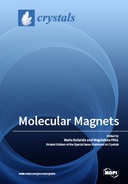Explore

Molecular Magnets
Magdalena Fitta and Maria Ba?anda
2019
0 Ungluers have
Faved this Work
Login to Fave
Molecular magnets show many properties not met in conventional metallic magnetic materials, i.e. low density, transparency to electromagnetic radiation, sensitivity to external stimuli such as light, pressure, temperature, chemical modification or magnetic/electric fields, and others. They can serve as “functional” materials in sensors of different types or be applied in high-density magnetic storage or nanoscale devices. Research into molecule-based materials became more intense at the end of the 20th century and is now an important branch of modern science. The articles in this Special Issue, written by physicists and chemists, reflect the current work on molecular magnets being carried out in several research centers. Theoretical papers in the issue concern the influence of spin anisotropy in the low dimensional lattice of the resulting type of magnet, as well as thermodynamics and magnetic excitations in spin trimers. The impact of external pressure on structural and magnetic properties and its underlying mechanisms is described using the example of Prussian blue analogue data. The other functionality discussed is the magnetocaloric effect, investigated in coordination polymers and high spin clusters. In this issue, new molecular magnets are presented: (i) ferromagnetic high-spin [Mn6] single-molecule magnets, (ii) solvatomagnetic compounds changing their structure and magnetism dependent on water content, and (iii) a family of purely organic magnetic materials. Finally, an advanced calorimetric study of anisotropy in magnetic molecular superconductors is reviewed.
This book is included in DOAB.
Why read this book? Have your say.
You must be logged in to comment.
Rights Information
Are you the author or publisher of this work? If so, you can claim it as yours by registering as an Unglue.it rights holder.Downloads
This work has been downloaded 276 times via unglue.it ebook links.
- 116 - pdf (CC BY-NC-ND) at Unglue.it.
Keywords
- ?-d system
- antiferromagnetic coupling
- antiferromagnetism
- Berezinskii-Kosterlitz-Thouless phase transition
- Chain
- Chemistry
- coordination polymers
- copper(II)
- critical behaviour
- Crystal structure
- cyano bridge
- cyclam
- dioxothiadiazole
- effect of high pressure
- exact diagonalization
- Heisenberg
- Heisenberg exchange Hamiltonian
- inelastic neutron scattering
- magnetic conductor
- Magnetic properties
- Magnetism
- magnetocaloric effect
- manganese(III)
- Mathematics & science
- molecular magnetism
- molecular magnets
- octacyanometallates
- octacyanotungstate(V)
- phase diagram
- Prussian blue analogues
- quantum magnet
- radical anion
- rectangular lattice
- redox
- S = 1/2 XXZ model
- salicylamidoxime
- single crystal heat capacity measurement
- single-molecule magnets
- spin anisotropy
- spin clusters
- square lattice
- Superconductivity
- superexchange interaction
- thema EDItEUR::P Mathematics and Science::PN Chemistry
- thermodynamic measurement
- Thermodynamics
Links
DOI: 10.3390/books978-3-03897-711-7Editions

